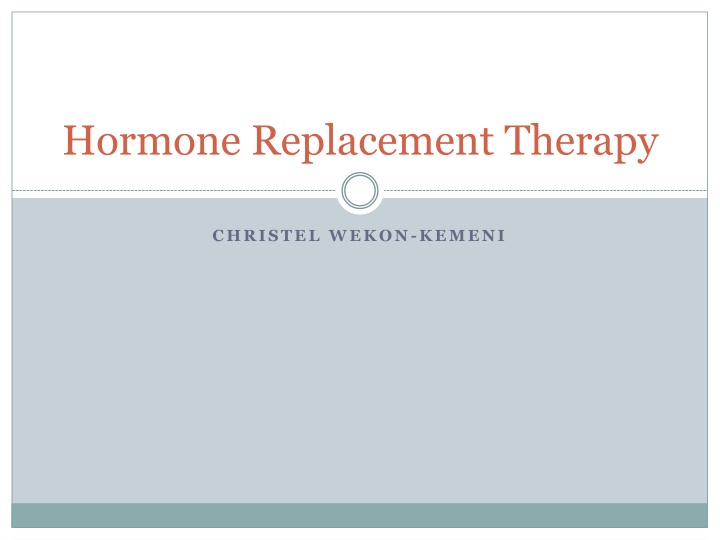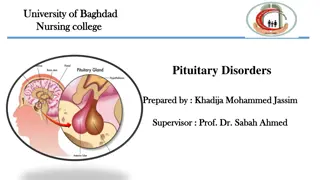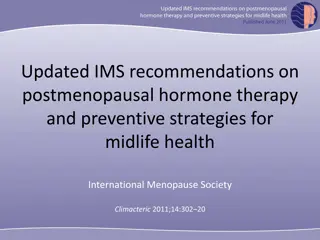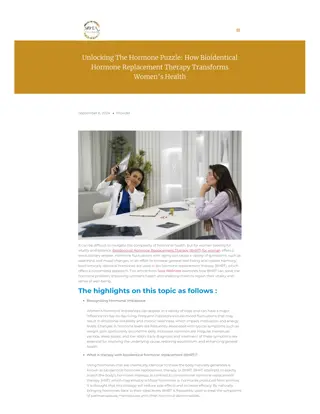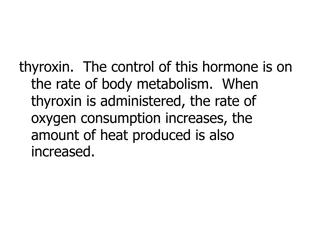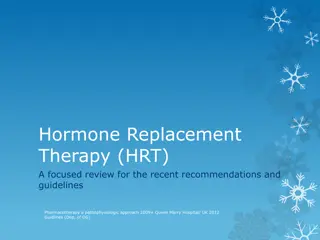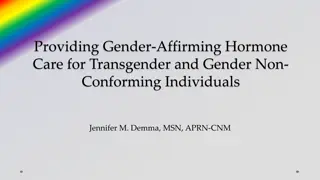Hormone Replacement Therapy
Learn about Hormone Replacement Therapy (HRT), its purposes, brief history, benefits, and risks. Understand the typical menopausal symptoms, differential diagnosis, and management options for patients. Get insights on the use of exogenous hormones in managing menopausal symptoms.
Download Presentation

Please find below an Image/Link to download the presentation.
The content on the website is provided AS IS for your information and personal use only. It may not be sold, licensed, or shared on other websites without obtaining consent from the author.If you encounter any issues during the download, it is possible that the publisher has removed the file from their server.
You are allowed to download the files provided on this website for personal or commercial use, subject to the condition that they are used lawfully. All files are the property of their respective owners.
The content on the website is provided AS IS for your information and personal use only. It may not be sold, licensed, or shared on other websites without obtaining consent from the author.
E N D
Presentation Transcript
Hormone Replacement Therapy CHRISTEL WEKON-KEMENI
Disclosures None.
Learning Objectives Define Hormone Replacement Therapy and explain why it is used Understand the typical presentation of menopause Provide a differential diagnosis and management plan for a patient needing HRT Describe the different options of HRT Outline the benefits and drawbacks/complications of HRT Counsel a patient about being on HRT
What is HRT? The use of exogenous female hormones to replace the declining levels of estrogen and progesterone witnessed in menopause Purposes of HRT: Preventive treatment against osteoporosis & heart disease Relief of menopausal symptoms
Brief History of HRT Estrogen was widely used to treat menopausal symptoms in the 1950s and 60s Link between estrogen-only therapy and endometrial cancer in postmenopausal women found in mid- 1970s It was discovered that the risk of endometrial cancer was reduced with the addition of progesterone to estrogen therapy
Brief History cont. Combination therapy was found to provide additional long-term protection against: Osteoporosis Heart disease Alzheimer disease In 2002, the Women s Health Initiative study linked HRT to a slightly increased risk of stroke, heart disease and breast cancer
A 51-year old G1P1001 woman comes into your clinic with complaints of irregular menstrual cycles and hot flashes. She first noticed her cycles becoming irregular two years ago, with her LMP being exactly 12 months ago. She also has noticed a decreased desire for sex as of late and wakes up tired most mornings.
Differential Diagnosis Pregnancy Polycystic ovary syndrome Hyperthyroidism Hypothyroidism Anorexia Depression Medication effects Carcinoid syndrome Menopause
Typical Presentation of Menopause Woman in her late 40s-early 50s with complaints of: Hot flashes Irregular menstrual cycles Weight gain Vaginal dryness Mood swings Heart palpitations Sleep disturbances Loss of sexual desire Urinary frequency & urgency
HRT Options Estrogen-only hormone therapy Oral combination estrogen/progestin therapy Cyclic therapy Continous therapy Transdermal or topical estrogen Bioidentical hormones Estrogen +/- progestin in a custom compounded base
Benefits of HRT Relief of hot flashes and night sweats Relief of vaginal dryness Protection against bone loss in osteoporosis Prevention of hip and spine fractures Reduced risk of colon cancer
Drawbacks of HRT Increased risk for breast cancer* Increased incidence of endometrial cancer Increased risk of thromboembolism Increased risk of cholelithiasis Slight increased risk of heart attack**
Relative Contraindications to HRT History of: Breast cancer Endometrial cancer Hypertriglyceridemia Thromboembolic disorders Undiagnosed vaginal bleeding Fibroids Endometriosis
Preparation for HRT Pap smear and breast examination Urinalysis Bone density test Blood tests RBC, blood sugar, cholesterol levels Liver & thyroid function Progesterone challenge test
Treatment Monitoring Patients should see doctor at least twice a year for checkups Annual surveillance to make sure that the patient is benefiting from treatment Complete physical on a yearly basis Coach patient to enact lifestyle changes
Summary Slide HRT is used to provide relief to patients suffering from menopausal symptoms Consider other potential diagnoses before diagnosing menopause There are multiple types of HRT that can be prescribed to patients Consider the contraindications of administering HRT There are multiple benefits and drawbacks to HRT Patients should be monitored while on HRT
Our patient decides to start combination HRT and will be assessed in six months. You tell her to contact you immediately if any vaginal bleeding occurs while on the therapy. She thanks you and is excited to start this treatment plan!
References "Hormone Replacement Therapy." The Free Dictionary. Farlex, n.d. Web. "Hormone Replacement Therapy (menopause)." Wikipedia. Wikimedia Foundation, 16 Aug. 2017. Web. "Hormone Therapy." Https://www.acog.org. N.p., n.d. Web. "Menopausal Hormone Replacement Therapy." Practice Essentials, Overview, Symptoms and Effects of Menopause. N.p., 06 Jan. 2017. Web. "Menopause." Menopause Key Highlights - Epocrates Online. N.p., n.d. Web.
